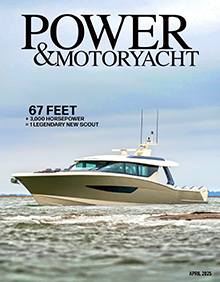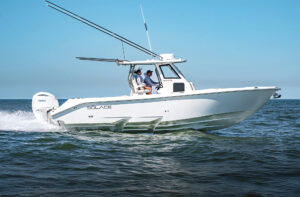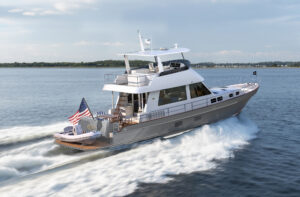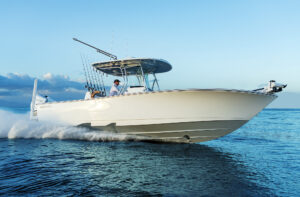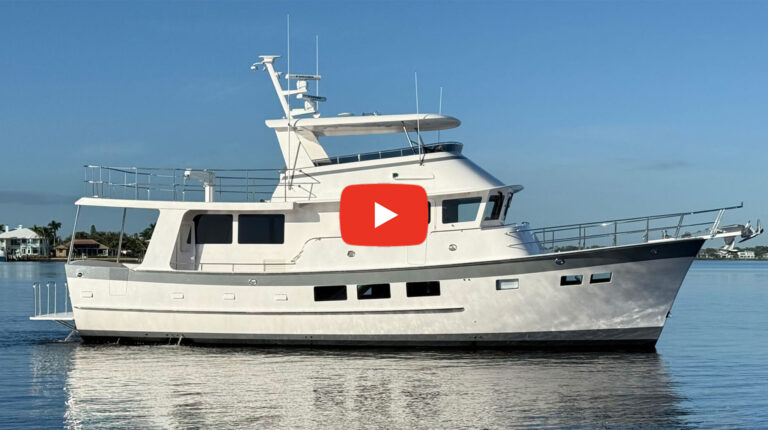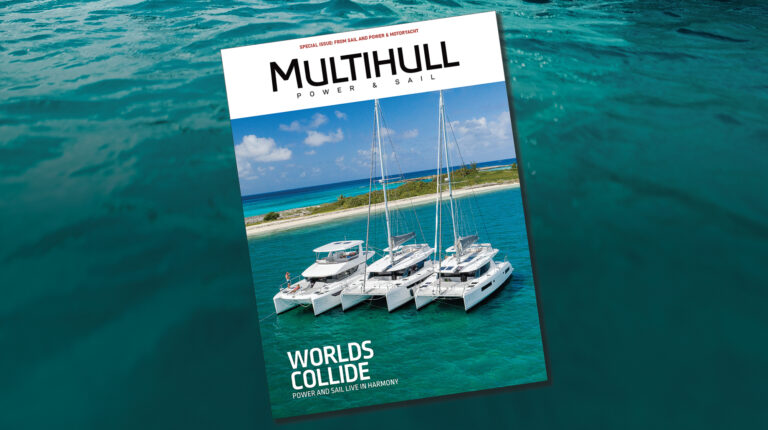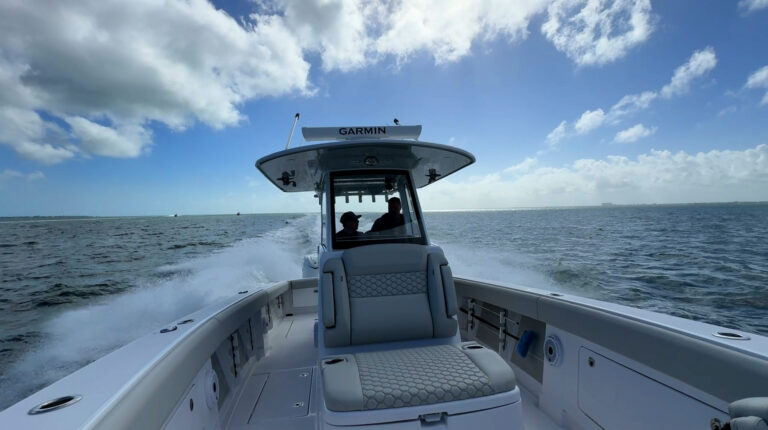A New Breed of Cat
High-performance catamarans offer a softer ride and higher speeds. It’s no wonder they’re poised to take a bite out of the center-console market.

The world’s fastest boats, whether powered by wind or fossil fuels, have one thing in common (well, multiple things actually): they’re multi-hulled catamarans. Why are catamarans faster? It boils down to hydrodynamics. Two slim hulls push less water than one deep V. With less resistance, catamarans run faster. Speed, however, is hardly the only benefit of a cat. A catamaran slices through the seas like a sharp sushi blade through a tuna belly. Cats don’t pound; they ride soft. Why? It’s basic physics.
A catamaran has two sharp edges entering the wave rather than one wide edge. This breaks up the waves and makes for a softer entry in a head sea. The same could be said in a quartering sea. The bow of a catamaran enters the seas one sponson at a time, which splits the waves for a smoother entry and a cushy landing.
When discussing catamarans versus monohulls, you could say the difference is akin to a knife versus a baseball bat. The knife cuts and stays on top of the waves while the bat pushes through. Yes, you can put the trim tabs down on a heavy deep-V hull and plow through the waves, but you’re going to burn a ton of fuel and the captain better pack a lunch, because it’s going to be a long day.

Catamarans are also wide and stable. The righting moment on a catamaran is less than a V-hull, and with the engines farther apart, they’re more maneuverable at low speeds and spin easily, making them ideal for fishing. But life as a cat isn’t all rosy. Catamarans have a few inherent issues that made some of the earlier outboard-powered, sportfishing incarnations a tough sell. The largest and wettest of those issues is hull sneeze. This occurs when the boat comes down over a wave and water pushes up against the tunnel between the two hulls and has nowhere to escape except out the front of the boat. The resulting sneeze shoots water out from under the bow and inevitably slaps you in the face. Riding on a boat with spray flying out the bow is about as comfortable as being stuck in an elevator with someone wearing overpowering cologne. There’s just nowhere to hide.
While cats eat up a head sea, some catamarans can get pretty squirrely in a following sea, digging and tracking erratically. The two hulls don’t always like to run in a straight line. Then there’s turning. Running a catamaran at a healthy clip takes some getting used to. While a V-bottom leans inboard in a turn, a cat tends to lean outboard. But there are ways to right all of these inherent issues and accentuate the benefits.
Catamarans are nothing new; they’ve been around since humans started to explore the oceans. About the most famous wayfinder known to mankind these days, Moana, sailed a double-hulled outrigger canoe inspired by the same one Polynesians used to ply the world’s oceans for thousands of years.

Several existing catamaran builders had proved that cats ride better in a head sea, but the burgeoning Florida market wanted a faster boat that aesthetically meshed with the go-fast center console look.
In 2007, the fledgling boat builder constructed a very different catamaran in the shed behind his house in Charleston, South Carolina. The boat was sleek, fast and fuel efficient. The boating world took notice.
“I knew from running a few catamarans that they rode better. I thought, What in the hell is wrong with people? Why would they get their teeth knocked out when they could ride better?” Freeman says. “But when you look back at cats in the mid-2000s, they didn’t have the look that people wanted, and obviously people wanted more speed. But the fastest boats in the world are offshore racing catamarans. I thought there’s got to be a way to make it happen. I took a different approach, a different way of thinking. It baffled me that no one had tried it.”
Freeman, a devout offshore angler to the core, routinely makes runs of 75 miles each way to find fish on the continental shelf. And oftentimes the weather will change, making getting home an arduous chore. He originally planned to build a boat for himself that could motor him to the fishing grounds faster and get the crew home safe and sound. During the construction process, he posted photos of the build to some online boating forums, and the public took notice.

“I could see people wanted it and there was a demand,” Freeman says. “I spoke to charter captains, and they said, ‘Man if this thing does what you say it’s going to do, we’re interested.’ The goal was if this works, it will change the industry. I think it’s done it.”
Freeman brought his 33-foot, one-off cat to the ultimate proving grounds for a fishing boat: Venice, Louisiana, where captains may run 200 miles in a single tuna trip through all manner of conditions. The reception was a bit mixed, but Freeman listened to the captains, made a few tweaks and sold two boats.
“It’s great working with Billy,” says Jesse Rhodes, who was a young boat designer when Freeman brought him on board to help design the first Freeman cats. “As a designer you’re essentially at the mercy of the builder. Billy likes to tweak stuff. It’s like working for a NASCAR sponsor who just wants to make the car go faster and faster.”
Freeman catamarans were fast out of the gate. The original 33 hit a top end of some 55 knots with twin 350-hp outboards. Customers were sold, and demand for larger boats poured in. Freeman expanded, offering a 37 and 42, and earlier this year, the company released a 47-footer with a 13-foot, 2-inch beam. All of the boats hit remarkable top-end speeds—the 47 can fly along at 70-plus knots with quad 450R Mercury outboards—but the trick is designing the boat to run the same despite the load. You add six anglers, 600 gallons of fuel, ice, full live wells, rods and reels, tackle and gear, and your boat just gained a ton of weight.

Freeman says the key to his design success is the way their boats handle load without sacrificing speed and ride. “The boat weighs 20,000 pounds dry, but fully loaded it can weigh 26,000 pounds. That’s a big dynamic swing in loading. You’ve got to design it to work light and heavy. It’s a little bit of guess work, but we’ve figured out a few formulas over the years,” Freeman says. “Call it talent or call it luck, but it’s worked so far.”
Freeman builds a symmetrical catamaran, meaning both of the hulls have the same shape. Other builders, including SeaHunter and Invincible, have entered the market with an asymmetrical catamaran. Offshore racing catamarans tend to go with an asymmetrical shape, where the deep side of the tunnel is relatively flat and the outside edge has the angle.
“Cats are good in a head sea but not so good in a following sea and not so good at turning. Those are things we wanted to design out of our boats, and that’s what our hybrid semi-asymmetrical multihull does,” says Scott Wood, senior VP of operations and engineering at Invincible Boats. “The boat will lean into a turn, not as much as a monohull, but it does lean in the right direction. And it’ll turn as hard as you want it to. When we get people out on a sea trial and say ‘now turn’ and the boat is going 55-plus mph, they’ll only turn the wheel a little bit. And we’ll say ‘go ahead, just turn,’ but it’s hard to get them to do it. They expect something to happen. But it doesn’t.”

The reason people expect something to happen is because some cats of yesteryear were known to bow steer, which causes wagging. Bow steering, technically speaking, is the tendency of a boat to go back and forth across the course line as it tries to crest the bow wave. As you go into a turn, a poorly designed cat doesn’t have enough buoyancy on the forward points of the hulls, so it dips to the opposite side of the turn because the force pushes that direction. This sinks the bow, and the boat leans the wrong way. Eventually the boat will correct and pop back up. What happens next is called “wagging” because the stern will let go and skip sideways like a happy dog’s bottom. You’ll know it when it happens. This sudden change in direction can be pretty violent, and you better be holding on.
To help with their hull design, Invincible brought in Morrelli & Melvin, a naval design firm that specializes in multi-hull vessels of all types, from Hobie cats to America’s Cup racers to big power cruisers. The Invincible catamaran uses a semi-asymmetrical stepped hull that has high sides and a wide tunnel between the sponsons.
“Our tunnel is 18 inches out of water and kind of U-shaped,” Wood says. “Compressed air, when the boat comes down, has to come back out. If you have too low of a tunnel, you get slap and you’ll hear it whap when it hits the bottom of the tunnel or sneezes out the front. The tunnel shape and size is critical.”
But for a boat to maintain a certain traditional Florida look, working with a high tunnel is tough. “You want the tunnel height high enough to clear water, but that’s what sets the deck height and therefore gunwale height. People will say the freeboard looks a bit high. Well, that’s necessary.” Invincible uses outboards with 30-inch shafts; other builders get away with more traditional 25-inch shafts.
The bow on a performance cat doesn’t rise like a deep-V when you jump out of the hole. The whole boat tends to come up and take off like a cheetah. Adjusting the running attitudes is something that each builder does a little differently. Invincible doesn’t use trim tabs at all, while Freeman uses them on some hulls, especially those with twin motors, but not on others.
“Our stepped hull runs at the angle it wants to run at,” Wood says. “There is no bow rise to think of.”

South Florida builder SeaHunter launched a 41-foot catamaran in 2018, and they have a 46 slated to launch later this year. All of their boats use trim tabs, and according to sales manager Eddie Leon, the trim tabs help owners coming out of traditional boats run a cat as they’re accustomed to running a monohull. The tabs also help the builder create boats with different layouts and loads because they know the ride can be adjusted. “Having trim tabs allows us to do more customizing knowing we have the ability to push the bow down,” he says. “We can hang heavier motors, put a tower on, add additional livewells; it’s another function we have.”
Boaters in South Florida want a vessel that they can easily beach at the sandbar and get in and out of while they snorkel. Cats offer that, with a large entry point between the motors. Boaters everywhere want a vessel that rides soft and doesn’t soak you; a well-designed catamaran does that too. And when it comes to speed and efficiency, well that box was the first one checked. It’s no wonder these fast cats are charging forward in the go-fast center console world.

